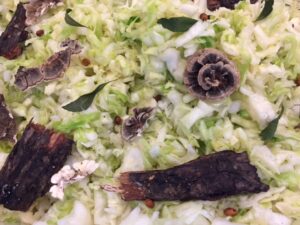
Dr. Schindler’s recipe calls for foraged wild ingredients, but you can easily use more readily available ingredients such as allspice, caraway, apples, etc.
Wild Sauerkraut: Dr. Schindler’s recipe calls for foraged wild ingredients, but you can easily use more readily available ingredients such as allspice, caraway, apples, etc.
Use whatever appeals to your palate.
Ingredients
- Cabbage
- Salt
- Local Dried Bayberry Leaves (2 per cabbage)
- Local Dried Spicebush Berries (3 per cabbage)
- Dried Turkey Tail Mushrooms (a few per cabbage)
- Charred Oak Bark (about a 2-inch by 4-inch piece per cabbage)
Steps
- Wash cabbage, remove the outermost dark leaves and reserve.
- Cut cabbage head into quarters from top to bottom. Remove stalk from each quarter with diagonal cut and reserve. Slice cabbage into desired size and place in bowl. Grate reserved stalks into bowl with sliced cabbage.
- Weigh cabbage and calculate amount of salt to add (cabbage weight x 0.02 = weight of salt). Add salt and massage with hands until moisture is released and cabbage begins to soften. Add all flavoring agents (spices, bark, mushrooms) and mix to combine.
- Pack in mason jar or crock (glass, ceramic and stainless steel are good containers; stay away from plastic and other metals). Use reserved dark green cabbage leaves to cover the sliced cabbage to keep together. Weigh down with plates, rocks, or glass weights (or any combination)!
- If the cabbage has not released enough liquid to be completely submerged after a few hours then add water/salt mixture at a ratio of 5% salt to water calculated by measuring the weight of the water and adding 5% of that weight in salt. Mix salt and water together and pour on top of cabbage.
- Set on counter and allow to ferment at room temperature for a few days. Once fermentation has begun move the crock into a slightly cooler area such as a basement to continue the ferment until it achieves the desired flavor and texture.
- Pack and transfer to a refrigerator to store.